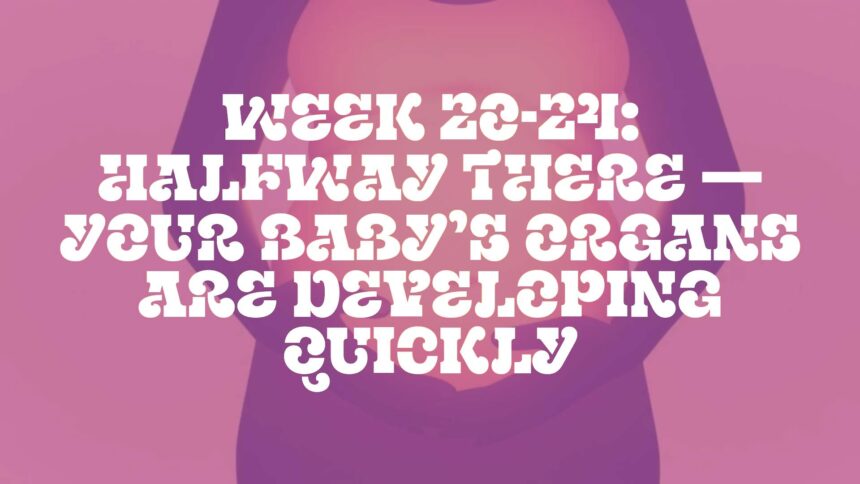You’re halfway through your pregnancy! Weeks 20 to 24 are a special time, filled with noticeable changes for both you and your baby. Your baby’s organs are maturing quickly and starting to work together. What was once a tiny group of cells is now beginning to look and act more like a newborn. These weeks bring many exciting developments as your baby gets ready for life outside the womb.
The main structures and organs formed in the first trimester, but now everything is growing and becoming more advanced. You can think of this phase like a finishing round for your baby’s internal organs-muscles, nerves, and organs are learning to work as a team. With each week, your baby gains weight and length, getting stronger and more prepared for birth.

You’re at the Halfway Mark: Weeks 20-24 Overview
Hitting week 20 means you’re right in the middle of your pregnancy. Many parents feel proud to reach this point and find themselves bonding more with their baby. By now, early symptoms like morning sickness and severe tiredness often fade. You may feel more energetic, and your growing belly becomes noticeable to others.
This part of pregnancy is often described as the most comfortable and enjoyable. Most earlier worries have eased, and the challenges of late pregnancy haven&rsquot started yet. You might start to enjoy feeling your baby moving and take real pleasure in watching your bump grow.
What changes happen in the second trimester?
From week 13 to week 27-the second trimester-you’ll likely notice less nausea and tiredness. Many people get a boost of energy, making it a good time to get things ready for your baby’s arrival, such as setting up the nursery or going to prenatal classes. Your uterus grows steadily, reaching your belly button by week 20, and this can bring new sensations like stretching pains or itchiness as your skin stretches.
Hormone levels change, but things settle down compared to the first trimester. Some hormones drop, while others like estrogen and progesterone keep the pregnancy strong. You may notice an increased appetite, stuffy nose, or bleeding gums due to changes in blood flow and hormone levels. One of the best moments in this trimester is feeling your baby move for the first time (called “quickening”), making the experience even more real for you.

How do weeks 20 to 24 fit into pregnancy months?
Pregnancy is usually counted in weeks with a full-term pregnancy lasting about 40 weeks, split into three trimesters of about three months each. Weeks 20 to 24 sit in the second trimester (week 13 to 27). Hitting week 20 means you’re ending your fifth month, right at the halfway mark. As you move to week 21, 22, 23, and 24, you’re in your sixth month. Pregnancy doesn’t always line up neatly with months, so it often lasts into a tenth month by the calendar, which is normal.
Doctors prefer counting by weeks rather than months since it’s more exact; for example, “five months pregnant” usually means about 20 weeks, but weeks give a clearer picture. This helps keep track of growth and plan for checkups and important tests.
Your Baby’s Growth: Organ Development in Weeks 20-24
Between weeks 20 and 24, your baby’s organs and systems are growing fast. Most of the key organs are already there, but now they’re getting better at their jobs. Your baby is practicing important skills they’ll need to live outside the womb-like moving, listening, and even sleeping in patterns.
During this time, you may notice your baby’s sleep and wake cycles. Their nervous system is making big leaps. Their skin is getting thicker, and tiny features like eyebrows and eyelashes are starting to show. Each week, your baby’s body and abilities become more developed and ready for life after birth.

Week 20: Big milestones and anatomy scan
Week 20 is special because your baby is about 6.3 inches (16 cm) long and weighs about 11 ounces (320 grams), similar to the size of a banana. They are starting sleep and wake cycles and may react to loud noises or your movements. Fingernails are growing, and skin is getting thicker with more layers.
The key event this week is the anatomy ultrasound scan. This detailed check looks at your baby’s brain, heart, kidneys, spine, face, and limbs. The technician checks each part carefully to confirm healthy growth. They also look at your placenta and measure fluid levels around your baby. This scan is an exciting chance to see your baby and, for some parents, to learn the baby’s sex.
Week 21: Senses and movement
At 21 weeks, your baby is growing even faster and will be about 9-10 inches long and weigh about 1 pound by the end of the month. Their senses are developing-though their ears are not perfect yet, they can start to hear sounds from outside the womb, like your voice and heartbeat. This helps them get used to the world they’ll soon enter.
Your baby’s movements are getting stronger and more deliberate. They’re now covered in a fine hair called lanugo, which helps keep a protective layer on their skin. Thumb-sucking begins, an important practice for feeding after birth. Hiccups may happen as well, which you might feel as little jerks. Their bone marrow starts making blood cells now, another sign of their growing maturity.
Week 22: Face and hair development
In week 22, your baby is about 1 pound (460 grams) and 7.5 inches (190 mm) from head to bottom. More human features show up-eyebrows and hair are visible, and their grip gets stronger. You might see your baby bring their hands to their face or grab the umbilical cord, showing better movement control.
For boys, the testes start to move into the scrotum. For girls, the uterus and ovaries are in place, and the vagina is formed. Your baby gets better at hearing sounds, such as your heartbeat or voice. Skin is still thin, but continues to build up layers.
Week 23: Skin and lung changes
At week 23, babies are about 8.25 inches (210 mm) long and weigh over 1.3 pounds (630 grams). Their skin looks wrinkled and almost see-through, with a reddish tint. Fat is starting to build up, which will help smooth out the skin soon. Ridges are forming on their hands and feet, setting up unique fingerprints and footprints.
Now, the lungs start making surfactant. This substance is needed for the lungs to work properly after birth. While lungs aren’t fully ready for breathing outside yet, this step is very important. Some babies born at this stage can survive with strong medical support because of how developed they are.
Week 24: Brain and organ advancement
By week 24, your baby weighs nearly 2 pounds (820 grams) and is about 9 inches (230 mm) long. Their skin is gaining color and isn’t as fragile. The brain grows quickly, developing more complicated activity and sleep cycles. Rapid Eye Movement (REM) sleep, a sign of brain growth, is happening more often.
Lungs keep making surfactant but aren’t quite ready for breathing outside yet. Other organs are also maturing. Your baby’s hearing is strong, and you might see your baby respond to familiar sounds, like your voice, by moving. The build-up of fat and organ development helps get your baby ready to live outside the womb.
What Does Your Baby Look Like: Weeks 20-24?
During weeks 20 to 24, your baby’s looks change a lot. They move from being almost see-through to looking more like a newborn. Their features-like their face and hair-become clearer. It’s an exciting time as they gain more fat, smooth out their skin, and start to show more personality in their appearance.
Baby’s Size and Appearance
Between week 20 and 24, your baby grows a lot, from about the size of a banana (6-7 inches) to around 12 inches and 2 pounds. This growth shows how quickly things are happening. Earlier in pregnancy, measurements go from head to bottom, but now that your baby is stretching out, doctors will often measure from head to heel.
During these weeks, their skin is coated in a creamy white substance called vernix, which protects them in the amniotic fluid. The skin looks wrinkled and may have a pink or red tint. Lanugo, a thin hair, covers their skin and holds the vernix in place. Hair, eyebrows, and eyelashes become more visible, making their features even more distinct.
Fingerprints, Hair, and Skin Development
By week 23, ridges on hands and feet appear, setting up unique fingerprints and footprints. Skin keeps getting thicker but might still look see-through and red due to blood vessels underneath. The fine lanugo hair and the greasy vernix serve important roles in protection. Hair on the head keeps growing, and facial features become clearer as the weeks go on.
When Will You Feel Your Baby Move?
Feeling your baby move for the first time is a special milestone called “quickening.” It often shows up around week 18 but becomes stronger and easier to notice by week 20. For first-time parents, movements can be mistaken for gas bubbles or odd muscle twitches at first.
Movements get stronger between weeks 20 and 24, becoming real kicks, turns, and punches. You’ll start to notice when your baby is awake and asleep and might feel them react to your voice or other noises. Healthcare providers can also view these actions on an ultrasound, giving you a glimpse of your baby’s activity.

Checkups and Tests During Weeks 20-24
Regular doctor visits during this stage are key to a healthy pregnancy. Your healthcare provider will monitor your and your baby’s health, share advice, and recommend important shots to protect you both. Regular care means any problems can be caught early and taken care of quickly.
The 20-Week Ultrasound Scan
The anatomy scan at 20 weeks is very important. This ultrasound checks all of your baby’s organs and measures their growth. The technician will look closely at the brain, heart, kidneys, spine, face, and limbs. The scan also shows where the placenta is and measures the amount of fluid around your baby. For many parents, this is a chance to find out the baby’s sex if you want to know. A normal scan brings relief, while early signs of a problem mean you can plan for extra care if needed.
Screenings and Vaccines in Weeks 20-24
During these weeks, your doctor will check your weight, blood pressure, and urine. Urine tests look for signs of health problems like preeclampsia or high blood sugar. These simple tests help your provider spot any possible troubles early.
Certain vaccines are recommended now, such as the whooping cough (pertussis) vaccine, usually given around week 20 but possible anytime between weeks 16 and 32. This shot helps protect your baby after birth, as the protection passes from you to your baby. If it’s flu season, you might also be offered a flu shot. These steps help safeguard both you and your baby for the rest of your pregnancy and after delivery.

